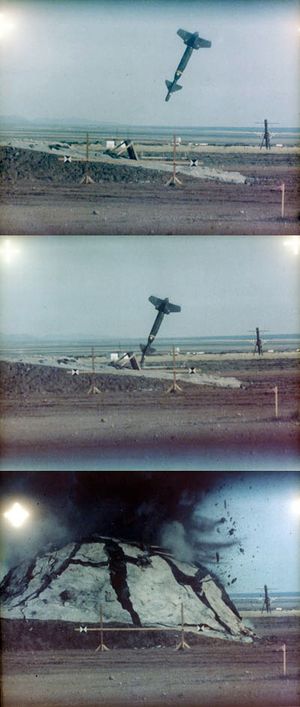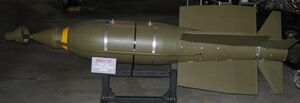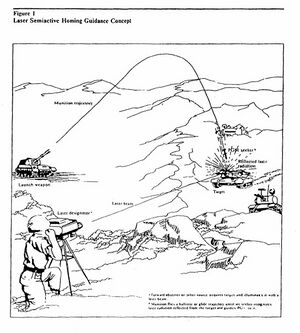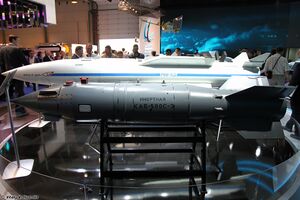ذخيرة موجهة بدقة
الذخيرة الموجهة بدقة (precision-guided munition؛ PGM؛ الأسلحة الذكية أو القنابل الذكية)، هي ذخيرة موجهة تهدف الاصابة الدقيقة لهدف معين، لتقليل الأضرار الجانبية وزيادة الفتك ضد الأهداف المقصودة.[1] خلال حرب الخليج الأولى، شكلت الذخائر الموجهة 9% فقط من الأسلحة التي تم إطلاقها، لكنها شكلت 75% من جميع الضربات الناجحة. على الرغم من استخدام الأسلحة الموجهة بشكل عام على أهداف أكثر صعوبة، إلا أنها لا تزال أكثر عرضة بنحو 35 ضعف لتدمير أهدافها لكل قنبلة يتم إسقاطه.[2]
نظرًا لأن تأثيرات الضرر الناجمة عن الأسلحة المتفجرة تتضاءل مع المسافة بسبب قانون المكعب العكسي، فحتى التحسينات المتواضعة في الدقة (وبالتالي تقليل مسافة الخطأ) تمكن من مهاجمة الهدف بقنابل أقل أو أصغر. وبالتالي، حتى لو أخطأت بعض القنابل الموجهة، فإن عددًا أقل من أطقم الطيران سيتعرض للخطر وقد يُقلل الضرر الذي يلحق بالمدنيين وحجم الأضرار الجانبية.[أ][ب]
أدى ظهور الذخائر الموجهة بدقة إلى إعادة تسمية القنابل القديمة "القنابل غير الموجهة" بالقنابل الغبية، أو القنابل الحديدية. من أبرز صانعي الذخائر الموجهة بدقة الولايات المتحدة وروسيا والصين والهند وإسرائيل وإيران وغيرها.
الأنواع
إدراكًا لصعوبة ضرب السفن المتحركة أثناء الحرب الأهلية الإسپانية،[9] كان الألمان أول من طور ذخائر قابلة للتوجيه، باستخدام التحكم اللاسلكي أو التوجيه السلكي. اختبرت الولايات المتحدة ذخائر موجهة بالتلفزيون (GB-4)،[10] أسلحة موجهة بالرادار شبه النشط (بات)، وأسلحة موجهة بالأشعة تحت الحمراء (فليكس).
التوجيه بالقصور الذاتي
سلاح الهجوم السلبي CBU-107 هو قنبلة موجهة تُسقط من الجو وتحتوي على قضبان معدنية خارقة بأحجام مختلفة. لقد تم تصميمه لمهاجمة الأهداف التي قد يكون فيها تأثير متفجر غير مرغوب فيه، مثل صهريج تخزين الوقود أو مخزون الأسلحة الكيميائية[11] في مناطق المدنيين.[12]
التوجيه اللاسلكي
كان الألمان أول من أدخل الصواريخ الموجهة بدقة في القتال، حيث قامت وحدة كي جي 100 بنشر القنبلة الانزلاقية المدرعة فريتز إكس الموجهة بنظام MCLOS، بوزن 1400 كجم، والموجهة عن طريق نظام التوجيه اللاسلكي كل-ستراسبورگ لمهاجمة البارجة الإيطالية روما بنجاح عام 1943،[13] والقنبلة الانزلاقية الموجهة هنشل إتش إس293 (تُستخدم أيضًا منذ عام 1943، لكن فقط ضد السفن المدرعة الخفيفة أو غير المدرعة).
كان أقرب القنابل المكافئة لدى الحلفاء، القنبلة VB-1 AZON التي يبلغ وزنها 450 كجم (التحكم من "AZimuth ONly")، المستخدمة في كل من مسرح العمليات الحرب العالمية الثانية في أوروپا والصين-بورما-الهند، وقنبلة بات التي تستخدمها البحرية الأمريكية، والتي استخدمت بشكل أساسي في مسرح عمليات المحيط الهادي- كانت بات أكثر تقدمًا من تصميم ذخائر PGM الألماني أو VB-1 AZON التابعة للقوات الجوية الأمريكية، حيث كانت مزودة بنظام رادار مستقل لتوجيهها إلى الهدف. بالإضافة إلى ذلك، اختبرت الولايات المتحدة الصاروخ گارگويل، الذي لم يدخل الخدمة مطلقًا.[14] الصواريخ اليابانية الموجهة بدقة - باستثناء المضادة للسفن التي تُطلق من الجو، وتعمل بالطاقة الصاروخية، بتحكم بشري، يوكوسوكا MXY-7 أهكا، القنبلة الطائرة "كاميكازه" لم تشهد قتالًا في الحرب العالمية الثانية.[15]
قبل الحرب، جرب البريطانيون طائرات موجهة لاسلكياً عن بعد ومحملة بالمتفجرات، مثل لارينكس. استخدمت القوات الجوية الأمريكية تقنيات مماثلة في العملية أفروديت، لكنها لم تحقق سوى نجاحات قليلة؛ لم تكن "الطائرة الطفيلية" الألمانية ميستل (Mistletoe) أكثر فعالية، حيث كانت توجه من قبل الطيار البشري الذي يقود المقاتلة ذات المحرك الواحد المثبتة فوق "القنبلة الطائرة" ذات المحركين، المسيرة، والمحملة بالمتفجرات أدناها. أطلقتها إحدى المقاتلات في هجوم ميستل.
استانفت الولايات المتحدة برامجها في الحرب الكورية. في الستينيات، أُعيد تقديم القنبلة الكهروضوئية (أو قنبلة الكاميرا). وكانت مجهزة بكاميرات تلفزيونية ومناظير مضيئة، يتم من خلالها توجيه القنبلة حتى تتراكب الشعلة على الهدف. وتنقل الكاميرات المفخخة "منظر عين القنبلة" للهدف إلى الطائرة المسيطرة. ثم يقوم أحد المشغلين في هذه الطائرة بإرسال إشارات التحكم إلى زعانف قابلة للتوجيه مثبتة على القنبلة. أُستخدمت هذه الأسلحة بشكل متزايد من قبل القوات الجوية الأمريكية في السنوات القليلة الأخيرة من حرب ڤيتنام لأن المناخ السياسي كان غير متسامح بشكل متزايد مع سقوط ضحايا من المدنيين، ولأنه كان من الممكن ضرب أهداف صعبة (مثل الجسور) بفعالية في مهمة واحدة؛ على سبيل المثال، تعرض جسر تانه هوا للهجوم بشكل متكرر بالقنابل الحديدية، لكن دون جدوى، ولم يسقط سوى باستخدام الذخائر الموجهة بدقة، وفي مهمة واحدة.
على الرغم من أنها ليست شائعة مثل أسلحة JDAM وJSOW الأحدث، أو حتى أنظمة القنابل الموجهة بالليزر الأقدم، إلا أن الأسلحة مثل AGM-62 Walleye الموجهة تلفزيونياً لا تزال قيد الاستخدام، جنبًا إلى جنب مع AAW-144 Data Link Pod، في طائرات إف 18 هورنت التابعة للبحرية الأمريكية.
التوجيه بالأشعة تحت الحمراء / الكهروضوئية
في الحرب العالمية الثانية، قامت لجنة أبحاث الدفاع الوطني الأمريكية بتطوير القنبلة ڤي بي-6 فليكس، التي تستخدم الأشعة تحت الحمراء للوصول إلى هدفه على متن السفن. على الرغم من أنها دخلت مرحلة الإنتاج في 1945، إلا أنها لم تستخدم مطلقًا.[16] كانت أول ذخيرة ناجحة موجهة كهروضوئياً هي AGM-62 Walleye أثناء حرب ڤيتنام. لقد كانت عائلة من القنابل الانزلاقية الكبيرة التي يمكنها تتبع الأهداف تلقائيًا باستخدام اختلافات التباين في بث الڤيديو. تأسس المفهوم الأصلي من قبل المهندس نورمان كاي أثناء العبث بأجهزة التلفزيون كهواية. كان يعتمد على جهاز يمكنه تتبع الأشياء على شاشة التلفزيون ووضع "صورة ضوئية" عليها للإشارة إلى المكان الذي يستهدفه. كان الاختبار الأول للسلاح في 29 يناير 1963 ناجحًا، حيث أصاب السلاح هدفه إصابة مباشرة. وخدم بنجاح لثلاثة عقود حتى التسعينيات.[17][18]
يعد ريثيون ماڤريك أكثر الصواريخ الموجهة كهروضوئياً شيوعاً. باعتباره صاروخًا ثقيلًا مضادًا للدبابات، فهو يمتلك من بين أنظمة التوجيه المختلفة مثل التوجيه الكهروضوئي (AGM-65A)، والتوجيه بالأشعة تحت الحمراء (AGM-65D)، والتوجيه بالليزر (AGM-65E).[19]
الأولان، من خلال توجيه أنفسهم بناءً على المشهد المرئي أو مشهد الأشعة تحت الحمراء للهدف، هما صاروخان ذكيان حيث يمكن للطيار إطلاق السلاح وسوف يوجه نفسه إلى الهدف دون مزيد من التدخل، مما يسمح للطائرة بالمناورة للهروب من النيران. القنبلتان الپاكستانيتان NESCOM H-2 MUPSOW وH-4 MUPSOW هما قنبلتان موجهتان كهروضوئياً (التوجيه بالأشعة تحت الحمراء والتوجيه التلفزيوني) هما قنابل انزلاقية ذكية موجهة بدقة. قنبلة إلبيت الإسرائيلية أوفير هي أيضًا قنبلة موجهة بالأشعة تحت الحمراء والتي تواردت تقارير بأنها أرخص بكثير من القنابل الموجهة بالليزر ويمكن استخدامها بواسطة أي طائرة، ولا تتطلب أسلاكًا متخصصة لمحدد ليزر أو لطائرة أخرى لإلقاء الضوء على الهدف. أثناء قصف الناتو لكوسوڤو عام 1999، استخدمت AF AMX الإيطالية الجديدة القنبلة أوفير.[20]
التوجيه بالليزر
في 1962، بدأ الجيش الأمريكي البحث في أنظمة التوجيه بالليزر وبحلول عام 1967 أجرت القوات الجوية الأمريكية تقييمًا تنافسيًا أدى إلى التطوير الكامل لأول قنبلة موجهة بالليزر في العالم، BOLT-117، عام 1968. تعمل جميع هذه القنابل بنفس الطريقة تقريبًا، حيث تعتمد على إضاءة الهدف أو "طلائه" بواسطة محدد الليزر على الأرض أو على متن طائرة. ولها عيب كبير يتمثل في عدم إمكانية استخدامها في الأحوال الجوية السيئة حيث لا يمكن رؤية إضاءة الهدف، أو حيث لا يمكن لمحدد الهدف الاقتراب من الهدف. يرسل محدد الليزر شعاعه في سلسلة مشفرة من النبضات بحيث لا يمكن الخلط بين القنبلة بالليزر العادي، وأيضًا حتى يتمكن العديد من المحددات من العمل على مسافة معقولة.
بدأ المشروع في الأصل بحثاً عن صواريخ أرض-جو تطورها بواسطة تكساس إنسترومنتس. عندما حاول گلن پنيستن، المدير التنفيذي لتكساس إنسترومنتس، بيع التكنولوجيا الجديدة إلى القوات الجوية، استفسروا عما إذا كان من الممكن بدلاً من ذلك استخدامها كنظام هجوم أرضي للتغلب على المشكلات التي كانوا يواجهونها فيما يتعلق بدقة القصف في ڤيتنام. بعد 6 محاولات، تحسنت دقة السلاح من 50 متراً إلى 3 أمتار، وتجاوز متطلبات التصميم بشكل كبير. أُرسل النظام إلى ڤيتنام وكان أداؤه جيدًا. بدون وجود جرابات الاستهداف، كان لا بد من استهدافهم باستخدام ليزر محمول باليد من المقعد الخلفي لطائرة إف-ب فانتوم، لكن لا يزال أداؤها جيدًا. في النهاية أُسقطت أكثر من 28.000 قنبلة خلال الحرب.[21]
لم تصبح الأسلحة الموجهة بالليزر شائعة حتى ظهور الرقاقة الدقيقة. وقد ظهرت لأول مرة عمليًا في ڤيتنام، حيث أُستخدمت في 13 مايو 1972 في الهجوم الناجح الثاني على جسر تانه هوا ("فك التنين"). وكان هذا الجسر في السابق هدفًا لنحو 800 طلعة جوية أمريكية[22] (باستخدام أسلحة غير موجهة) وتم تدميره جزئيًا في كل من الهجومين الناجحين، والآخر وقع في 27 أبريل 1972 باستخدام قنابل والآي.
كما أُستخدمت، لكن ليس على نطاق واسع، من قبل القوات البريطانية أثناء حرب فوكلاندز 1982.[23]
أول استخدام واسع النطاق للأسلحة الذكية جاء في أوائل التسعينيات أثناء عملية حرب الخليج الثانية عندما استخدمتها قوات التحالف في العراق. ومع ذلك، فإن معظم الذخائر التي تم إسقاطها جواً والمستخدمة في تلك الحرب كانت "غبية"، على الرغم من أن النسب المئوية متحيزة بسبب الاستخدام الكبير لمختلف القنابل العنقودية (غير الموجهة). استُخدمت الأسلحة الموجهة بالليزر بأعداد كبيرة أثناء حرب كوسوڤو 1999، لكن فعاليتها غالبًا ما انخفضت بسبب الظروف الجوية السيئة السائدة في جنوب البلقان.
پاڤواي هي سلسلة من القنابل الموجهة بالليزر المصنوعة في الولايات المتحدة. قنابل پاڤواي 2 (230 كجم) (مثل GBU-12) هي ذخيرة أرخص وخفيفة الوزن وموجهة بدقة مناسبة للاستخدام ضد المركبات والأهداف الصغيرة الأخرى، في حين أن پاڤواي 3 (910 كجم) خارقة (مثل GBU -24) وهو سلاح أكثر تكلفة مع كفاءة ديناميكية هوائية محسنة ومناسبة للاستخدام ضد أهداف ذات قيمة عالية. أُستخدمت قنابل GBU-12 بشكل موسع في الحرب الإيرانية العراقية، حيث تم إسقاطها من طائرات F-111F لتدمير المركبات المدرعة العراقية في عملية أشار إليها الطيارون بشكل غير رسمي باسم "طقطقة الدبابات."
- سكيپر 2 هو صاروخ قصير المدى موجه بالليزر طورته البحرية الأمريكية. كان المقصود من سكيپر أن يكون سلاحًا مضادًا للسفن، قادرًا على تعطيل أكبر السفن برأس حربي impact-fuzed يزن 450 كجم.
- يتكون من قنبلة مارك 83 مزودة بمجموعة توجيه پاڤواي وصاروخين يعملان بالوقود الصلب من طراز Mk 78 يتم إطلاقهما عند الإطلاق.
- سودارشان هي مجموعة قنابل هندية موجهة بالليزر، طورتها مؤسسة تطوير الطيران، مختبر أبخاث وتطوير الدفاع بدعم تكنولوجي من مختبر أبحاث وتطوير دفاعي آخر يسمى مؤسسة أبحاث وتطوير الأجهزة،[24][25] لصالح القوات الجوية الهندية.[26][27][28]
- KAB-1500L وKAB-500L هي قنابل روسية موجهة بالليزر.
- LT PGB هي عائلة ذخيرة صينية موجهة بالليزر.
- LS PGB هي عائلة ذخيرة صينية موجهة بالليزر.
- نظام سلاح القتل الدقيق المتقدم (APKWS) المعروف أيضًا باسم الصاروخ الموجه بالليزر بالأشعة تحت الحمراء (LiGR) هو تحويل تصميمي لمجموعة صواريخ هايدرا 70 الغير موجهة بالليزر لتحويلها إلى ذخائر موجهة بدقة.[29][30][31]
- أوگروزا (روسية: Угроза، وتعني "الوعيد") هو نظام أسلحة موجه بدقة صنع في روسيا الاتحادية. وهو ترقية للصواريخ الروسية "الغبية" القياسية، بما في ذلك إس-5، إس-8، وصاروخ إس-13.[32][33]
يقوم النظام بترقية الصواريخ "الغبية" باستخدام التوجيه بالليزر، مما يزيد من دقتها بشكل كبير. يتطلب الأمر محدد ليزر، إما من مصدر جوي أو أرضي، "لتلوين" الهدف. ويصل الخطأ الدائري المحتمل لهذا النظام حوالي 0.8-1.8 متر،[32] بينما يختلف المدى الأقصى للصواريخ عن الصواريخ المستخدمة من 1.5 إلى 8 كم.[32] يسمح أوگروزا بإطلاق ما يصل إلى 7 صواريخ في المرة الواحدة.
- الجديد الملحوظ هو أن النظام لا يستخدم التحكم في الطيران الديناميكي الهوائي (على سبيل المثال، زعانف الذيل)، لكن التوجيه النبضي مع محركات دفع صغيرة.[34][32]
- روكتستان كيريت هو صاروخ تركي موجه بالليزر.
- قنبلة گريفين الموجهة بالليزر (Griffin LGB) هو نظام قنابل موجهة بالليزر من صنع قسم الصواريخ التابع لشركة إسرائيل للصناعات الجوية. وهي مجموعة إضافية تُستخدم لتحديث مارك 82 ومارك 83 ومارك 84 وغيرها من "القنبلة الغبية" الغير موجهة، مما يجعلها قنابل ذكية موجهة بالليزر (مع خيار التوجيه عن طريق GPS). انتهى من التطوير الأولي للنظام عام 1990.
- كيريت هو نظام صاروخي عيار 70 ملم موجه مزود بباحث موجه ليزر شبه نشط. جزء الباحث والتوجيه يكون مرفقاً برأس حربي مصمم خصيصًا لهذا الغرض مع ذخائر غير حساسة من الفئة الخامسة. يحتوي الرأس الحربي متعدد الأغراض على ذخيرة مدمجة خارقة للدروع مع تأثيرات معززة للدروع الخلفية مضادة للأفراد وحارق. المحرك ذو تصميم منخفض الدخان، مع خصائص الذخائر الغير حساسة. وهو متصل بالقسم الخلفي بواسطة محمل دوار يمكّنه من الدوران أثناء الطيران. توجد أربعة أسطح تثبيت صغيرة في الجزء الخلفي من الصاروخ أمام فوهة العادم مما يضمن طيرانًا مستقرًا. طورت روكستان حجرة إطلاق جديدة وعلبة جديدة يتم فيها تسليم الصاروخ كيريت كجولة شاملة. يتمتع كيريت بمدى توجيهي فعال يصل إلى 8 كم مع احتمالية عالية للضرب على هدف 3 × 3 متر في هذا النطاق.[35][36]
التوجيه بالرادار
يستخدم سلاح Lockheed-Martin هلفاير 2 خفيف الوزن المضاد للدبابات الرادار الموجود على بوينگ إيه إتش-64دي أپاتشي لونگبو لتوفير توجيه أطلق وانس لهذا السلاح.
التوجيه الساتلي
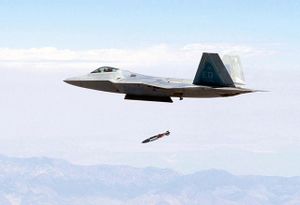
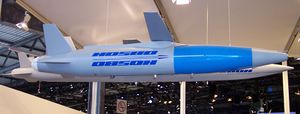
أظهرت الدروس المستفادة خلال الحرب الإيرانية العراقية قيمة الذخائر الدقيقة، لكنها سلطت الضوء أيضًا على الصعوبات في استخدامها - خاصة عندما تتدهور رؤية الأرض أو الهدف من الجو.[37] لا تؤثر مشكلة ضعف الرؤية على الأسلحة الموجهة ساتلياً مثل ذخائر الهجوم المباشر المشترك وسلاح المواجهة المشتركة، والتي تستفيد من دعم نظام تحديد المواقع العالمي الأمريكي للتوجيه. يمكن استخدام هذا السلاح في جميع الظروف الجوية، دون الحاجة إلى دعم أرضي. نظرًا لأنه من الممكن تشويش نظام تحديد المواقع العالمي، تعود حزمة التوجيه إلى الملاحة بالقصور الذاتي في حالة فقدان إشارة نظام تحديد المواقع العالمي. الملاحة بالقصور الذاتي أقل دقة بشكل ملحوظ؛ تحقق ذخيرة الهجوم المباشر المشترك [[خطأ دائري محتمل] يبلغ 13 مترًا تحت توجيه نظام تحديد المواقع العالمي، لكن الخطأ الدائر المحتمل عادة ما يبلغ 30 مترًا فقط تحت التوجيه بالقصور الذاتي (مع زمن سقوط حر يبلغ 100 ثانية أو أقل).[38][39]
- ذخائر الهجوم المباشر المشترك هي مجموعة أدوات توجيهية تحول القنابل غير الموجهة، أو "القنابل الغبية"، إلى ذخائر "ذكية" صالحة لجميع الأحوال الجوية. توجه القنابل المجهزة بذخائر الهجوم المباشر المشترك بواسطة نظام ملاحة بالقصور الذاتي متكامل مقترن بجهاز استقبال نظام تحديد المواقع العالمي، مما يمنحها نطاقًا منشورًا يصل إلى 28 كم. يتراوح وزن القنابل المجهزة بذخائر الهجوم المباشر المشترك من 230 إلى 910 كجم.[40]
عند تثبيتها على قنبلة، تُعطى مجموعة ذخائر الهجوم المباشر المشترك تسمية GBU (وحدة القنابل الموجهة)، لتحل محل تسمية القنبلة التي تنتمي إليها مارك 80 أو BLU (وحدة القنبلة الحية).
- 'القنبلة منخفضة السحب عالية السرعة هي سلسلة من الذخائر الموجهة بدقة تستخدمها القوات الجوية الهندية. منها وزنين 450 كجم و500. تستخدم هذه القنابل نظام الملاحة بالقصور الذاتي ونظام تحديد المواقع العالمي/نظام السواتل الملاحية الإقليمي الهندي للتوجيه الساتلي في منتصف المسار والليزر شبه النشط للتوجيه النهائي.
- موزع الذخائر المصحح بالرياح (WCMD) هي مجموعة ذخائر أمريكية موجهة بنظام نظام تحديد المواقع العالمي/نظام الملاحة بالقصور الذاتي للاستخدام مع عائلة موزع الذخائر التكتيكية من القنابل العنقودية لتحويلها إلى ذخائر موجهة بدقة.
- وان تشين – هي النسخة الأصلية التايوانية من ذخائر الهجوم المباشر المشترك.[41]
- تتكون مجموعة تحويل گريفين من قسم "الباحث" الأمامي ومجموعة من ذيول الطائرات الخلفية القابلة للتوجيه. تتميز الذخيرة الموجهة الناتجة بـ "تشكيل المسار"، والذي يسمح للقنبلة بالسقوط على مجموعة متنوعة من المسارات - من زاوية ضحلة إلى هجوم علوي عمودي. بحسب شركة إسرائيل للصناعات الجوية يبلغ الخطأ الدائر المحتمل للسلاح 5 أمتار.[42]
- GBU-57A/B السلاح المخترق المدمر (MOP)، هي قنبلة أمريكية موجهة بدقة مخترقة للتحصينات، يبلغ وزناه 14.000 كجم.[43] وهي أكبر بكثير من أكثر الصواريخ اختراقاً للتحصينات المتاحة سابقًا، وهي جي بي يو 28 وجي بي يو 37 التي يبلغ وزنها 2.300 كجم.
- SMKB (Smart-MK-Bomb)، هي مجموعة قنابل برازيلة موجهة بدقة، تحول قنابل مارك 82 (230 كجم) أو مارك 83 (450 كجم)، إلى قنابل موجهة بدقة. تُسمى على التوالي يُسمى على التوالي SMKB-82 وSMKB-83. توفر المجموعة نطاقًا ممتدًا يصل إلى 50 كم ويتم توجيهها بواسطة نظام ملاحة بالقصور الذاتي مقترن بثلاث شبكات ساتلية (نظام تحديد المواقع العالمي وگاليليو وگلوناس)، وتعتمد على الاتصال اللاسلكي للتعامل مع تدفق البيانات بين الطائرة والذخيرة.
- FT PGB هي عائلة ذخائر صينية موجهة ساتلياً وبالقصور الذاتي.
- LS PGB هي عائلة ذخائر صينية موجهة بنظام تحديد المواقع العالمي+نظام ملاحة بالقصور الذاتي أو بالليزر.
تعتمد دقة هذه الأسلحة على دقة نظام القياس المستخدم لتحديد الموقع والدقة في تحديد إحداثيات الهدف. ويعتمد الأخير بشكل حاسم على معلومات استخباراتية، ليست جميعها دقيقة. وفقًا لتقرير المخابرات المركزية الأمريكية، فإن القصف الأمريكي للسفارة الصينية في بلگراد العرضي أثناء عملية قوات التحالف من قبل طائرات الناتو يُعزى إلى معلومات خاطئة عن الهدف.[44] ومع ذلك، إذا كانت معلومات الاستهداف "دقيقة"، فمن الأرجح أن تحقق الأسلحة الموجهة ساتلياً ضربة ناجحة في أي ظروف جوية معينة مقارنة بأي نوع آخر من الذخائر الموجهة بدقة.
مفاهيم التوجيه المتقدمة
ردًا على تقارير ما بعد العمليات من الطيارين الذين استخدموا أسلحة موجهة بالليزر أو موجهة ساتلياً، قامت بوينگ بتطوير منظومة ليزر-ذخيرة الهجوم المباشر المشترك (LJDAM) لتوفير كلا النوعين من التوجيه في مجموعة واحدة. استنادًا إلى تكوينات ذخيرة الهجوم المباشر المشترك الحالية، تضاف حزمة توجيه بالليزر إلى السلاح الموجه بنظام الملاحة بالقصور الذاتي/نظام تحديد المواقع العالمي لزيادة دقته الإجمالية.[45] قامت ريثيون بتطوير عائلة پيڤواي المحسنة، والتي تضيف توجيه نظام الملاحة بالقصور الذاتي/نظام تحديد المواقع العالمي إلى مجموعة پيڤواي الخاصة بحزم التوجيه بالليزر.[46] تسمح هذه الأسلحة "الهجينة" الموجهة بالليزر ونظام تحديد المواقع العالمي بحمل عدد أقل من أنواع الأسلحة، مع الاحتفاظ بمرونة المهمة، لأن هذه الأسلحة يمكن استخدامها بالتساوي ضد الأهداف المتحركة والثابتة، أو الأهداف السانحة. على سبيل المثال، تضمنت حمولة الأسلحة النموذجية على طائرة إف-16 أثناء تحليقها خلال حرب العراق صاروخًا واحدًا من طراز JDAM يبلغ وزنه 910 كجم واثنين من قاذفات LGB بوزن 1000 450 كجم.
- سپايس هي مجموعة توجيه إسرائيلية EO/GPS لتحويل قنابل غير موجهة يمكن إسقاطها جوًا إلى قنابل موجهة بدقة. يمكن برمجة سپايس مسبقًا، بما يصل إلى 100 هدف مختلف قد يتعين عليه التعامل معها أثناء المهمة. الهدف الوحيد الذي سيشتبك معه "فعلياً" يمكن بعد ذلك اختياره على متن الطائرة من قبل أحد أفراد الطاقم.
- مجموعة توجيه (HGK)، تركية: Hassas Güdüm Kiti / Precision Guidance Kit)، طورتها شركة TÜBİTAK-SAGE، هي مجموعة توجيه بنظام GPS/INS تحول قنابل مارك 84 بوزن 910 كجم إلى قنابل ذكية. وهي تتيح القدرة على الضرب الدقيق في جميع الظروف الجوية بمدى طويل عند تشتت يبلغ 6 أمتار.[47]
- وحدة تسليح إير-سول (AASM)،[48][49] طورتها سافران للإلكترونيات والدفاع، تتضمن مجموعة أدوات توجيه أمامية ومجموعة أدوات توسيع المدى مثبتة في الخلف ومتطابقة مع القنابل الغبية. السلاح معياري لأنه يمكنه دمج أنواع مختلفة من وحدات التوجيه وأنواع مختلفة من القنابل. ويستخدم التوجيه الهجين نظام الملاحة بالقصور الذاتي/نظام تحديد المواقع العالمي. تضيف المتغيرات الأخرى التوجيه بالأشعة تحت الحمراء أو التوجيه بالليزر لزيادة الدقة.
- پيڤواي 4 هي قنبلة ذات توجيه مزدوج (نظام تحديد المواقع العالمي/نظام الملاحة بالقصور الذاتي والتوجيه بالليزر من إنتاج بواسطة ريثيون المملكة المتحدة (ريثيون المحدودة للأنظومة سابقًا).[50] وهي أحدث إصدارات سلسلة پيڤواي.
- دنل دينامكس أومباني مجموعة قنابل موجهة بدقة تم تصنيعها بواسطة دنل دينامكس في جنوب أفريقيا. وتتكون من عدد من الوحدات المجهزة بقنابل السقوط الحر القياسية مارك 81 أو مارك 83 لتحويلها إلى قنابل انزلاقية.[51]
- السلاح الذكي المضاد للمطارات (SAAW) هو سلاح مضاد للمطارات هندي موجه بدقة تم تطويره بواسطة مركز أبحاث إمارات التابع لمنظمة البحث والتطوير الدفاعية، بمدى يصل إلى 100 كم.
- القنبلة عالية السرعة منخفضة السحب (HSLD) هي ذخيرة هندية موجهة بدقة تم تطويرها بواسطة مؤسسة أبحاث وتطوير الأسلحة ويمكن مقارنتها بسلسلة مارك 80 الأمريكية. وتستخدم القصور الذاتي والملاحة الساتلية مع مجموعة توجيه بالليزر لتحقيق دقة الهدف.
- جولة المدفعية للأهداف المتحركة (MTAR)
- تقود البحرية الأمريكية تطوير قذيفة مدفعية جديدة عيار 155 ملم تسمى جولة المدفعية للأهداف المتحركة، وهي قادرة على تدمير الأهداف المتحركة في البيئات التي لا يتوفر فيها نظام تحديد المواقع العالمي. يقوم مكتب الأبحاث البحرية، مركز الحرب السطحية البحرية قسم دالگرين، ومختبر أبحاث الجيش الأمريكي بتنسيق تطوير النظام، ومن المقرر أن يكتمل تطويره النهائي عام 2019.[52]
- تشمل الميزات الرئيسية لقذيفة جولة المدفعية للأهداف المتحركة نطاقًا ممتدًا ضد الأهداف المتحركة، والتوجيه الدقيق والملاحة بدون نظام تحديد المواقع العالمي، ونمطية النظام الفرعي، ونضج النظام الفرعي، وتوافق نظام الأسلحة، والارتفاع المحدود، والقدرة على جميع الأحوال الجوية، وتقليل وقت الرحلة، والقدرة على تحمل التكاليف. الذخيرة الجديدة مخصصة لمدافع الهاوتزر M777A1 التابعة للجيش أو مشاة البحرية، وإم109A6 پالادين، وM109A7 پالادين للإدارة المتكاملة (PIM) وأنظمة المدفعية ذاتية الدفع عيار 155 ملم. ستكون القذيفة أيضًا مخصصة لنظام الأسلحة البحرية المتقدم على متن المدمرات طراز زوموالت، وأنظمة الأسلحة البحرية المستقبلية الأخرى.[53]
- مجموعة التوجيه الدقيق – مودرنايزيشن (PGK-M)
- يخطط الجيش الأمريكي للبيئات التي لا تعمل بنظام تحديد المواقع العالمي باستخدام مجموعة التوجيه الدقيق الجديدة - مودرنايزيشن (PGK-M). تعزيزًا للتقنيات السابقة، سيمنح PGK-M القوات الأمريكية القدرة على مواصلة إطلاق ضربات دقيقة عندما يخترق العدو نظام تحديد المواقع العالمي.[54]
- يقود مهندسو پيكاتيني أرسنال عملية تطوير بديل لنظام تحديد المواقع العالمي باستخدام التنقل بالصور لتوجيه الذخائر بدقة، تحت إشراف مركز أبحاث التسلح والتطوير والهندسة. ومن بين شركاء البحث الآخرين معامل دراپر، مختبر أبحاث الجيش الأمريكي، مختبر أبحاث القوة الجوية ومركز الأبحاث والتطوير وهندسة الطيران والصواريخ.[55]
- ويمكن للذخيرة المحسنة التنقل إلى الموقع المطلوب، من خلال صورة مرجعية تستخدمها التكنولوجيا للوصول إلى الهدف.[55]
يشتمل PGK-M على مجموعة من شبكات الراديو المخصصة للبرمجة، وأنواع مختلفة من تقنيات اتصال ترحيل الموجات والتكنولوجيا الملاحية.[54]
- PBK-500U Drel هي قنبلة انزلاقية شبح روسية مقاومة للتشويش.
القذائف الموجهة من المدافع وقذائف الهاون
تُطلق القذائف الموجهة من المدفعية أو مدفعية السفن أو المركبات المدرعة. قامت العديد من الوكالات والمنظمات برعاية برامج القذائف الموجهة من المدفعية. قامت البحرية الأمريكية برعاية برنامج ديدآي، وهو عبارة عن قذيفة موجهة بالليزر لمدافعها عيار 127 مم وبرنامج لتزويد نظام توجيه پيڤواي بقذيفة عيار 203 مم، لمدافع مارك 71 (8"/55) في السبعينيات (Photo). وتشمل الجهود البحرية الأخرى قذائف BTERM، ERGM، وLRLAP.
- يمكن اعتبارً صاروخ الجيش الأمريكي، MGM-51 شيللاگ، نوعاً من القذائف الموجهة من المدفعية. وهو مخصص للاستخدام على الدبابة الخفيفة إم 551 شريدان، يًُطلق صاروخ شيللاگ من مدفع الدبابة شريدان لتوفير قدرة قوية مضادة للدبابات. استخدم الجيش الأمريكي طلقة المدفعية الموجهة بالليزر إم 712 كوپرهد أثناء حرب الخليج الثانية. تتضمن القذائف الموجهة من المدفعية التابعة للجيش الأمريكي قذيفة مدفعية إم982 إكساليبور عيار 155 مم، وXM395 Precision Guided Mortar Munition، وXM1156 Precision Guidance Kit إلى إعادة تجهيز القذائف الموجودة من عيار 155 ملم بتوجيه دقيق، حيث يقوم برنامج JDAM التابع لالقوات الجوية الأمريكية بتحويل القنابل الغبية إلى ذخائر موجهة بدقة.
- إم982 إكساليبور، هي ذخيرة موجهة بنظام تحديد المواقع العالمي (XM982) للمدفعية عيار 155 مم في جهد تعاوني بين مختبر أبحاث الجيش الأمريكي (ARL) ومركز أبحاث وتطوير الأسلحة (ARDEC). وشملت الأبحاث تطوير نظام تحديد المواقع العالمي والأنظمة الكهروميكانيكية الدقيقة (MEMS) وتقنية الاستشعار بالقصور الذاتي. أُستخدم إكساليبور صيف 2007 أثناء حرب العراق. كما طُبقت التكنولوجيا التي تم تطويرها على إكساليبور في مجموعة التوجيه الدقيق للجيش (PGK) لاستخدامها في المقذوفات التقليدية الموجودة ومجموعة أدوات توجيه الهاون (MGK) للاستخدام في قذائف الهاون التقليدية.[56]
- الذخيرة متوسطة المدى إكس إم 1111، هو صاروخ ملغى يُطلق من مدفعية دبابة عيار 120 مم.
- LAHAT، هو صاروخ إسرائيلي موجه بالليزر شبه النشط منخفض الوزن ومضاد للدبابات ويمكن إطلاقه من مدافع الدبابات ذات السبطانة الملساء.
- KSTAM، هي ذخيرة موجهة كورية جنوبية تُطلق من مدفعية دبابة كي2 بلاك پانثر.
- 30إف39 كرانسوپول، هي قذيفة متفجرة نصف آلية موجهة بالليزر، تُطلق من مدفعية عيار 152/155 مم. في النهاية تستقر القذيفة تلقائيًا على نقطة مضاءة بواسطة محدد ليزر، تُشغل عادةً بواسطة مراقب مدفعية أرضي.
- كيتولوڤ-2إم، هي قذيفة مدفعية روسية موجهة بالليزر عيار 120/122 مم، مزودة بنظام التحكم في النيران لمدفعية ملاخيت الآلية.[57][58]
- 9إم119 سڤير/رفلكس، هي قذائف موجهة بالليزر تُطلق من مدفعية دبابة.
- Pansarsprängvinggranat m/94 STRIX، هي قذيفة سويدية موجه في الطور النهائي، تُطلق من مدفع هاون عيار 120 مم يتم تصنيعه حاليًا بواسطة سآب بوفورز داينامكس.
- يُطلق STRIX مثل قذيفة الهاون التقليدية. تحتوي القذيفة على مستشعر تصوير بالأشعة تحت الحمراء تستخدمه لتوجيه نفسها نحو أي دبابة أو مركبة قتالية مدرعة في المنطقة المجاورة حيث تهبط. الباحث مصمم لتجاهل الأهداف المشتعلة بالفعل.[59]
- بصير، هي قذيفة إيرانية متفجرة موجه بالليزر، تطُلق من على مدفعية عيار 155 مم، لتدمير دبابات ومركبات العدو أو أي هدف آخر متحرك أو غير متحرك، بدقة عالية.[60] هذا السلاح مشابه في وظيفته للسلاح الروسي كراسنوپول أو الأمريكي إم712 كوپرهد.[بحاجة لمصدر]
- سمارت 155، هي قذيفة مدفعية ألمانية عيار 155 مم، مصممة للهجوم العلوي بالنيران الغير مباشرة ضد المركبات المدرعة بعيدة المدى. تحتوي القذيفة الحاملة لنظام سمارت على اثنتين من القنابل العنقودية مع مستشعر الأشعة تحت الحمراء ورادار بتردد فائق العلو، والتي تنزل فوق ساحة المعركة على بالوتات (مظلات) وتهاجم أهداف محصنة برؤوس حربية اختراقية متفجرة. هذه الذخائر الصغيرة مصممة خصيصًا بآليات متعددة للتدمير الذاتيقالب:Dubious-inline كي تقع خارج فئة أسلحة الذخائر الصغيرة المحظورة بموجب اتفاقية اتفاقية الذخائر العنقودية 2008.
- سامهو، هو صاروخ هندي موجه مضاد للدبابات يُطلق من مدفعية، تم تطويره بواسطة مؤسسة أبحاث وتطوير التسلح (ARDE) لدبابات أرجون التابعة للجيش الهندي.
- ذخائر راينميتال دنيل 155 مم V-LAP[61][62]
- GP1، هي قذيفة مدفعية صينية موجهة بالليزر عيار 155 مم يعتمد تصميمها على كراسنوپول الروسي.[63][64][65]
- GP6، هي قذيفة مدفعية صينية موجهة بالليزر عيار 155 مم يعتمد تصميمها على كراسنوپول الروسي.
- XM395 Precision Guided Mortar Munition
- Strix mortar round
- KM-8 Gran، هي قذيفة هاون روسية موجهة عيار 120 مم مزودة بنظام ملاخيت للتحكم في النيران.[66][67][68][69][70]
- GP120 (GP4)، عبارة عن قذيفة هاون صينية مصححة من عيار 120 مم.[71]
- GP140، هي قذيفة هاون صينية عيار 120 مم موجهة بالليزر شبه النشط.
الأسلحة الخفيفة الموجهة
تم تطوير نماذج أولية موجهة بدقة من الأسلحة الخفيفة تستخدم محدد ليزر لتوجيه رصاصة يتم تشغيلها إلكترونيًا إلى الهدف.[72] هناك نظام آخر قيد التطوير يستخدم محدد مدى الليزر لإطلاق قذيفة أسلحة خفيفة متفجرة بالقرب من الهدف. ويخطط الجيش الأمريكي لاستخدام مثل هذه الأجهزة مستقبلياً.[73]
عام 2008، بدأ برنامج إكزاكتو تحت إشراف دارپا لتطوير نظام بندقية قنص ذكي يتضمن رصاصة ذكية موجهة ونطاقًا محسّنًا. لم يُكشف عن التقنيات الدقيقة لهذه الرصاصة الذكية. أختبر إطلاق إكزاكتو في عامي 2014 و2015، وأظهرت النتائج أن الرصاصة غيرت مسارها لتصحيح المسار إلى هدفها.[74]
عام 2012 أعلنت معامل سانديا الوطنية عن نموذج أولي لرصاصة ذاتية التوجيه يمكنها تتبع هدف مضاء بمحدد الليزر. الرصاصة قادرة على تحديث موقعها 30 مرة في الثانية وضرب الأهداف على بعد ميل واحد.[75]
في منتصف 2016، كشفت روسيا أنها تعمل على تطوير سلاح "رصاصة ذكية" مماثل، مصمم لضرب أهداف على مسافة تصل إلى 10 كيلومترات.[76][77]
پايك[78] هو صاروخ صغير موجه بدقة يتم إطلاقه من قاذفة قنابل يدوية.
قاذفات القنابل اليدوية الانفجارية الهوائية هي نوع من الأسلحة الموجهة بدقة. يمكن لقاذفات القنابل هذه برمجة قنابلها اليدوية مسبقًا باستخدام نظام التحكم في الحرائق لتنفجر في الهواء فوق العدو أو بجانبه.[79][80][81]
انظر أيضاً
الهوامش
- ^ "During Russia’s participation in the Syrian Civil War, only one of its aircraft, the Su-34 fighter-bomber, regularly used precision-guided munitions, Bronk explained, and even that aircraft often used unguided bombs and rockets.".[3]
- ^ Connectivity to GLONASS may be a factor in the lack of Russian PGM availability,[4] and the use of 3G/4G cell towers for Russian encrypted communications (Era) [5] during the 2022 Russian invasion of Ukraine. This weakness was unearthed during the use of open communication ("Russian commanders are sometimes piggybacking on Ukrainian cell phone networks to communicate")[6] when FSB was discussing the deaths of their generals: Vitaly Gerasimov, killed 7 Mar 2022;[7] Andrei Sukhovetsky, killed 28 Feb 2022.[8][4]
- المصادر
- ^ Hamilton, Richard (1995). "Precision guided munitions and the new era of warfare". Air Power Studies Centre, Royal Australian Air Force. Retrieved 2009-02-02.
- ^ https://www.washingtonpost.com/archive/lifestyle/magazine/2002/12/15/bursts-of-brilliance/0c06b132-2d70-41e6-882e-5c4ece8f5fcf/
- ^ David Roza (3 Mar 2022) Where is the Russian Air Force? Experts break down why they might be hiding "It is clear to us that Russia is losing aircraft and helicopters at a damaging rate." —Justin Bronk, RUSI
- ^ أ ب Jamie Ross, who cites Christo Grozev of Bellingcat: (Tue, March 8, 2022, 5:32 AM) (7 March 2022) Russian Officer Complains About Dead General and Comms Meltdown in Intercepted Call FSB (Federal Security Service, successor agency to the KGB) officers discuss Gerasimov's death amid the destruction of 3G/4G cell towers in Ukraine, and the loss of Russian encrypted communications (Era), which compromised the FSB officer's sim-card-enabled phone call.
- ^ Rob Waugh (8 March 2022) 'Idiots': Russian military phone calls hacked after own soldiers destroy 3G towers 3G/4G Towers Needed For Russian encrypted communications (Era)
- ^ MEHUL SRIVASTAVA, MADHUMITA MURGIA, AND HANNAH MURPHY, FT (3/9/2022, 8:33 AM) The secret US mission to bolster Ukraine’s cyber defences ahead of Russia’s invasion European official: "instead of communicating solely through encrypted military-grade phones, Russian commanders are sometimes piggybacking on Ukrainian cell phone networks to communicate, at times simply by using their Russian cell phones. 'The Ukrainians love it—there is so much data in simply watching these phones, whether or not they are using encrypted apps,' he said. The Ukrainians then block Russian phones from their local networks at key moments, further jamming their communications. 'Then you suddenly see Russian soldiers grabbing cell phones off Ukrainians on the street, raiding repair shops for sims,' he said. 'This is not sophisticated stuff. It’s quite puzzling."
- ^ Rob Picheta and Jack Guy, CNN (8 Mar 2022) Ukraine claims Russian general has been killed in Kharkiv
- ^ Doug Cunningham (3 Mar 2022) Ukraine forces say Chechen commander Magomed Tushayev killed near Kyiv
- ^ Fitzsimons, Bernard, editor. The Illustrated Encyclopedia of 20th Century Weapons and Warfare (London: Phoebus, 1978), Volume 10, p.1037, "Fritz-X".
- ^ Fitzsimons, op. cit., Volume 10, p.1101, "GB-4".
- ^ Air Force Developed Bombs Capable of Destroying Syria’s Chemical Weapons - Defensetech.org, 30 August 2013
- ^ "CBU-107 Passive Attack Weapon (WCMD)". www.globalsecurity.org.
- ^ Fioravanzo, Giuseppe (1971). La Marina italiana nella seconda guerra mondiale – Volume XV – La Marina dall'8 settembre 1943 alla fine del conflitto [The Italian Navy in the Second World War – Volume XV – The Navy from 8 September 1943 to the End of the Conflict] (in الإيطالية). Rome: Italian Navy Historical Branch. pp. 8–34.
- ^ Fitzsimons, op. cit., Volume 10, p. 1090, "Gargoyle".
- ^ Martin Caidin (1956). "Japanese Guided Missiles in World War II". Journal of Jet Propulsion. 26 (8): 691–694. doi:10.2514/8.7117.
- ^ Fitzsimons, op. cit., Volume 9, p. 926, "Felix".
- ^ Parsch, Andreas (2002). "Martin Marietta AGM-62 Walleye". Directory of U.S. Military Rockets and Missiles. Designation-Systems. Retrieved 9 July 2014.
- ^ John Darrell Sherwood, Nixon's Trident: Naval Power in Southeast Asia, 1968–1972, (Washington: DC: Naval Historical Center, forthcoming).
- ^ "Raytheon AGM-65 Maverick" (PDF). Archived from the original (PDF) on 20 October 2006.
- ^ "Opher bomb deployed in Kosovo" FLIGHT Daily News, 17 June 1999
- ^ خطأ استشهاد: وسم
<ref>غير صحيح؛ لا نص تم توفيره للمراجع المسماةwashingtonpost.com - ^ Thanh Hoa Bridge Archived 9 نوفمبر 2005 at the Wayback Machine
- ^ "Britain's Small Wars". Archived from the original on 20 January 2011.
- ^ Dehradun, 20 Oct (PTI) (20 October 2010). "India develops first Laser Guided Bomb". Deccanherald.com. Retrieved 2012-02-19.
{{cite web}}: CS1 maint: numeric names: authors list (link) - ^ Nitsi (2010-10-21). "India invents 1st Laser Guided Bomb". News.oneindia.in. Retrieved 2012-02-19.
- ^ "India conducts flight trials of laser-guided bombs". Netindian.in. 2010-01-21. Retrieved 2012-02-19.
- ^ India develops first laser guided bomb, MSN News, http://news.in.msn.com/national/article.aspx?cp-documentid=4480246&_p=544152d2-2200-4721-9dbc-eff67faec052#page=1, retrieved on 27 December 2016
- ^ "India successfully develops advanced laser guided bomb". News.xinhuanet.com. 2010-10-20. Archived from the original on 24 October 2010. Retrieved 2012-02-19.
- ^ "APKWS® laser-guidance kit".
- ^ U.S. Army Plans First Deployment of Laser-Guided Rocket – Ainonline.com, 14 October 2015
- ^ "Description the APKWS II is a design conversion of an unguided Hydra 2.75-inch rocket with a laser guidance kit to give it precision-kill capability. | NAVAIR - U.S. Navy Naval Air Systems Command - Navy and Marine Corps Aviation Research, Development, Acquisition, Test and Evaluation". Archived from the original on 7 November 2015. Retrieved 1 April 2017.
- ^ أ ب ت ث Vladimir Ilyin (18 September 1999). "Cheaply and effectively". Nezavisimaya Gazeta (in الروسية).
- ^ "Defense & Security Intelligence & Analysis: IHS Jane's | IHS".
- ^ Usa, Ibp (7 February 2007). Russia Air Force Handbook. International Business Publications, USA. ISBN 9781433041150.
- ^ "CIRIT 2.75" Laser Guided Missile, Roketsan". Archived from the original on 1 January 2009.
- ^ Roketsan targets guided anti-tank missile development and production, TR Defence, 13 July 2011
- ^ "News". www.af.mil.
- ^ U.S. Air Force Factsheets: Joint Direct Attack Munition
- ^ John Pike. "Joint Direct Attack Munition (JDAM)". globalsecurity.org. Retrieved 1 April 2015.
- ^ "JDAM continues to be warfighter's weapon of choice". Archived from the original on 2012-10-26. Retrieved 2007-07-27.
- ^ "Taiwan develops 'anti-invasion' munitions against China". Fox News. 2013-09-21. Retrieved 2017-03-09.
- ^ "Laser-Guided Bomb Kits". Israel Aerospace Industries. Retrieved 20 February 2013.
- ^ B-2/Massive Ordnance Penetrator (MOP) GBU-57A/B. FedBizOpps
- ^ "DCI Statement on the Belgrade Chinese Embassy". Archived from the original on 4 October 2006.
- ^ "Weapons" (PDF). boeing.com. Retrieved 1 April 2015.
- ^ "Raytheon Enhanced Paveway" (PDF). Archived from the original (PDF) on 7 March 2008.
- ^ TÜBİTAK SAGE Archived 26 مارس 2013 at the Wayback Machine
- ^ "Safran Electronics & Defense".
- ^ "Armement Air-Sol Modulaire (AASM) HAMMER Air-to-Ground Missile". www.airforce-technology.com.
- ^ "Paveway IV". Royal Air Force. Archived from the original on 31 December 2014. Retrieved 7 January 2015.
- ^ "Umbani Brochure" (PDF). Denel Dynamics. Retrieved 2012-06-18.
- ^ Trevithick, Joseph. "U.S. Navy Wants Long-Range Guided Artillery Shell For Hitting Moving Targets". The Drive. Retrieved 2018-07-12.
- ^ "Army and Navy to develop prototype artillery smart munition able to hit moving targets without GPS". www.militaryaerospace.com. 13 April 2018. Retrieved 2018-07-12.
- ^ أ ب "The Army Is Preparing Artillery For Battles Without GPS". Popular Mechanics. 2018-04-10. Retrieved 2018-07-12.
- ^ أ ب "Researchers develop technology for precision munitions even without GPS". www.army.mil. Retrieved 2018-07-12.
- ^ Ratches, James A.; Richard, Chait; Lyons, John W. (February 2013). "Some Recent Sensor-Related Army Critical Technology Events". www.dtic.mil. Archived from the original on 20 June 2017.
- ^ "KBP Instrument Design Bureau - Kitolov-2M". Archived from the original on 16 July 2021. Retrieved 6 January 2018.
- ^ http://roe.ru/pdfs/pdf_1914.pdf[bare URL PDF]
- ^ "Sweden and Switzerland, last customers of Strix 120mm mortar munition | October 2018 Global Defense Security army news industry | Defense Security global news industry army 2018 | Archive News year". www.armyrecognition.com. 17 October 2018.
- ^ "مهمات هوشمند و لیزری «بصیر» رونمایی شد+عکس". مشرق نیوز. 30 January 2012.
- ^ "South African company Denel produces new artillery rounds 81003173 | weapons defence industry military technology UK | analysis focus army defence military industry army". 10 March 2017.
- ^ https://www.rheinmetall-defence.com/media/editor_media/rm_defence/publicrelations/pressemitteilungen/2014_1/aad/2014_09_17_AAD_10_Rheinmetall_Denel_Munition.pdf[bare URL PDF]
- ^ "功能维护升级中".
- ^ http://www.janes360.com/images/assets/423/54423/precision-guided_munitions_for_field_artillery.pdf[bare URL PDF]
- ^ "Somebody's Popping off Laser-Guided Shells in Libya". 13 November 2017.
- ^ "Ancile".
- ^ https://ndiastorage.blob.core.usgovcloudapi.net/ndia/2016/armament/18259_Williams.pdf[bare URL PDF]
- ^ "KBP Instrument Design Bureau - Gran". Archived from the original on 12 November 2018. Retrieved 24 November 2017.
- ^ "Final Report".
- ^ "The "Gran" guided weapon system for 120mm mortars КМ-8 | Catalog Rosoboronexport".
- ^ "Enhanced capability for WMA029 mortar system - China Military". Archived from the original on 1 April 2017. Retrieved 22 November 2017.
- ^ "Sandia's self-guided bullet prototype can hit target a mile away".
- ^ Kleiner, Kurt (2009-06-06). "Radio-controlled bullets leave no place to hide". New Scientist. Retrieved 2009-06-14.
- ^ https://www.darpa.mil/news-events/2015-04-27[وصلة عارية]
- ^ Sandia’s self-guided bullet prototype can hit target a mile away
- ^ Russians Launch Smart Bullet Effort in the Wake of U.S. Program - Kitup.Military.com, 20 July 2016
- ^ "Russia launches 'smart bullet' testing in guided flight regime". TASS.
- ^ "Raytheon Unveils New Mini Missile for Special Forces, Infantry - Defensetech". Archived from the original on 13 December 2017. Retrieved 12 December 2017.
- ^ "Grenade Launchers and their Ammunition: International Developments". Small Arms Defense Journal.
- ^ http://www.quarryhs.co.uk/GRENADES%20WEB%20ARTICLE.pdf[bare URL PDF]
- ^ https://www.orbitalatk.com/defense-systems/armament-systems/cdte/
وصلات خارجية
 Media related to ذخيرة موجهة بدقة at Wikimedia Commons
Media related to ذخيرة موجهة بدقة at Wikimedia Commons- A Brief History of Precision Guided Weapons
- How Smart Bombs Work
- BBC: "Smart bombs missed Iraqi targets" — on the first employment of the JSOW, guidance failures from a software error subsequently fixed.
- "Fact File: Smart Bombs – not so Smart" BBC story discussing the limitations of guided munition employment.
- Janes.com: "Ukraine develops indigenous guided airborne weapons" — 2006 article about Ukrainian guided bomb development.
- "World War II Glide Bombs" (Part1)
- "World War II Glide Bombs" (Part2)
- "World War II Glide Bombs" (Modern Glide Bombs)
- "Soviet/Russian Guided Bombs" by Air Power Australia
- CS1 الإيطالية-language sources (it)
- CS1 maint: numeric names: authors list
- CS1 الروسية-language sources (ru)
- All articles with bare URLs for citations
- Articles with bare URLs for citations from March 2022
- Articles with PDF format bare URLs for citations
- Articles with bare URLs for citations from August 2022
- Short description is different from Wikidata
- Articles with hatnote templates targeting a nonexistent page
- Articles containing روسية-language text
- Pages using Lang-xx templates
- Articles with unsourced statements from July 2021
- توجيه الأسلحة
- قنابل جوية
- استهداف (حرب)
